

The Raven ZZ plant boasts a striking deep black color!
Raven ZZ facts
Name: Zamioculcas zamiifolia Raven™
Cultivar: Zamioculcas zamiifolia ‘Dowon’
Common name: Raven ZZ plant
Family: Araceae
Type: houseplant
Hardiness: zone 9+ (US) or H1 (UK)
Height & Width: 1 ½ to 3 feet (45-90 cm) – Exposure: well-lit – Soil type: draining mix
Many are familiar with the survivor plant Zamioculcas zamiifolia. Give your Raven proper water, exposure and care. It’s among the trendiest indoor plants ever!

Growth rate and exposure needs are identical to all ZZ plant varieties, as long as they’re planted correctly.
It’s dark black through-and-through. But new “sports” are appearing as propagation repeats. These are sometimes variegated (ZZ raven variegata) with white or pink spots and even albino white leaves.
The main care it needs is simply repotting.
If ideal growing conditions are met, this plant sends up a new shoot fast. Indeed, it can grow up to an inch in three days (1 cm/day).
Most of the time it seems to stay dormant, usually because it’s a bit cold or dark.
For instance, during the winter season, new leaves are rare.
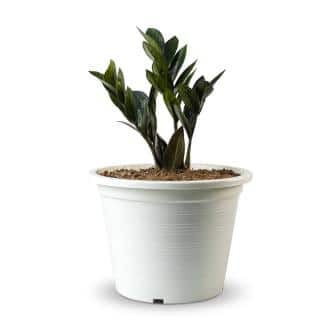
This plant will stay small in size if you keep it in smaller pots.
→ Zamioculcas zamiifolia raven cannot survive colds lower than 40°F (5°C).
Zamioculcas raven, originating from the African-born ZZ plant, is a flexible plant: it copes well with irregular watering.
 Watering in summer – water a small amount every two weeks.
Watering in summer – water a small amount every two weeks.Allow the soil to dry out entirely before watering again. Zamioculcas raven has tuber-like rhizomes that store water. Letting soil dry out avoids root rot.
Misting helps leaves stay alive longer (and makes cleaning easier, too).
Zamioculcas raven will survive in very low light conditions.
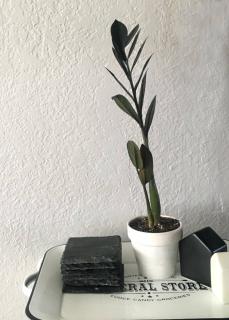
If you’re keeping the plant outdoors, prefer part sun only in the early morning or late afternoon.
Time is what makes the black ZZ plant turn dark. Fresh leaves start out bright green and gradually turn black with time.
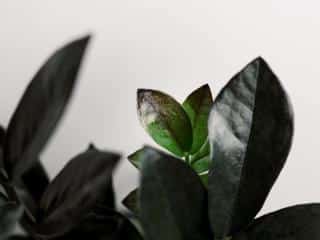
The pigment that makes the raven ZZ black is fragile: when a leaf dies, the black color fades to normal yellow and brown.
Exposure to strong lights or artificial lighting only influences color a tiny bit, so no point investing in such devices for your Raven ZZ.
The ZZ plant is famous for being extra-resistant: you won’t have many problems with this plant.
It’s very rare for the Raven ZZ to fall sick. When it does, you’ll notice yellowing leaves and collapsing, mushy stems. It’s usually a sign that it needs better, more regular care. Indeed, a healthy ZZ raven will fend off any pests on its own.
Make sure your watering schedule is right, and check the link below for specific issues (yellow leaves, leaf drop, bugs and insects…)
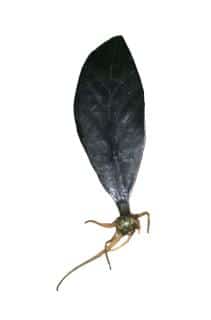
Techniques that work best are crown division, leaf cuttings (shown on the picture to the left), and stem cuttings.
Note: the Raven ZZ plant has a patent on it. It cannot legally be multiplied and sold in many countries. Only nurseries who deal with the original breeder can do this.
In other words, the only thing you can do is prepare a personal back-up in case your main plant dies off!
Non-lethal calcium oxalate crystals appear in all parts of the plant. As a result, sap can be mildly irritating to sensitive skins. Wear gloves to repot or split your plant.
Furthermore, calcium oxalate crystals may wreck havoc in animal digestive systems. Though not deadly, dogs and cats will get sick if they ingest too much of it.
Provide cats with plants like nepeta instead to satisfy their need for greens!
The ZZ plant is a great choice for offices and homes, and this crow-colored variety is no exception.
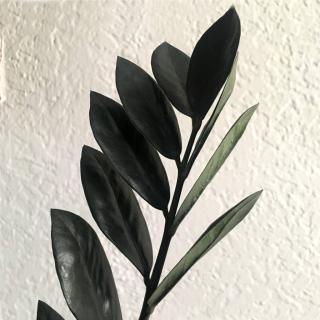
Hyuk Jin Lee, a plant breeder, noticed a plant with a single dark-colored branch among the regular Zamioculcas.
He filed for a patent in the United States. Year later, officials granted the patent on Christmas day, December 25th, 2018! The cultivar’s name is ‘Dowon’.
The discovery is protected until 2033 with plant patent number PP30035.
It is now a common find in large garden centers and online across the world.
Imports are allowed from abroad, provided the grower also has an agreement with Van Winden-Erica.
This black-colored leaf houseplant is a wonderful addition to the home. It pairs well with arrangements that include tall orchid flowers because the contrast is elegant and water needs are very similar!
What’s the best thing to wipe the leaves with to keep them looking beautiful?
Hi Cassandra! The healthiest for the plant would be to dip a rag or soft cloth in rainwater, and gently wipe dust away. Rainwater or distilled water (such as for ironing clothes) is best since it won’t leave any mineral deposits behind, but the occasional use of tap water will also do fine. Use water that’s at room temperature. If your plant is really lush with lots and lots of leaves, hold it over the edge of the shower and let water patter down on it, to rinse all the dust away in a single go.
Thank you very much!
Interesting! In Australia, on the West coast Raven has been released. The PBR applicant for Raven was Lee Hyuk Jin, in 2018. But on the East coast, the black ZZ we have is ‘Jungle Warrior’. This PBR was lodged by a Kwekerij Harold Heemskerk B.V., in 2019. I am yet to find a difference between the Raven and Jungle Warrior, but I am wondering what differences there could be in order to have separate PBR…
Great article regarding this plant, was searching for comprehensive information for zz ravenen for quite some time. Keep up the good work.
Thanks, will do, of course! Doing our best is what makes the world a better place!